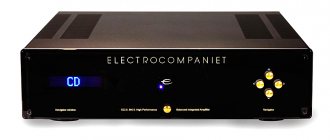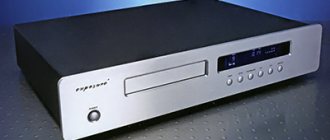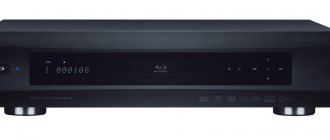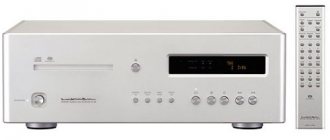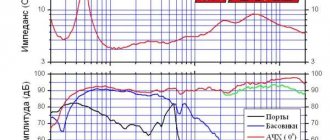Pioneer VSA-AX 10Ai-S Dot the i's. Magazine "DVD Expert"
The Pioneer VSA-AX10Ai-S is a true “music machine”, which is a rarity in this segment.
Save and read later -
Dot the i's
AV amplifier Pioneer VSA-AX1OAi-5 In 2001, the brand new Pioneer VSA-AX10 won the prestigious European EISA award. Four years have passed since then, and the exceptionally successful device has gone through several modifications. Today we present to your attention Pioneer’s “final” answer to the modern competitive race in the high-end device segment - the VSA-AX10Ai-S model. How is it different from previous amplifiers? What can compete with the ultra-modern monsters from Yamaha or Denon? What's What When it comes to AV components, Pioneer has always offered the best bang for your buck—and the top-of-the-line VSA-AX10Ai-S AV amplifier follows that philosophy. Competitors' equipment, with poorer equipment, sometimes costs more - but hasn't the pursuit of everything the most fashionable affected the final sound quality? This is exactly what we tried to find out by conducting long and detailed testing of the new product. In addition, the “internals” of the Pioneer VSA-AX10Ai-S were examined so that now you can easily navigate such a delicate topic. However, let's not forget that all innovations are worthless if the device in which they are embodied cannot captivate with its sound. Description How does the Pioneer VSA-AX10Ai-S differ from its predecessors? First of all, the company modified the remote control. The inconvenient rectangular block is a thing of the past, turning into a modern “magic wand”, stylized as a pocket computer. It has basic keys for quick control, and fine-tuning, as before, is possible from the touch panel. Well, now the control of the device is organized quite ergonomically and communicating with it has become much easier. In addition, the remote control does not operate on batteries, but on a rechargeable battery, and the kit includes a desktop charger - an extremely convenient solution! Through the USB port, the amplifier can receive and decode audio data in the new WMA computer format. “Under the hood”, the Pioneer VSA-AX10Ai-S has powerful chips - two ADSP21161N from Analog Devices and two DSP56367 from Motorola, providing 96 bits of computing power and allowing the automatic tuning and equalization of all channels to function. Thanks to the latest version of the MCACC system, the owner of the device can completely forget about manual settings, limiting himself to placing the supplied microphone at the listening point. The AV amplifier will do everything on its own and will be ready for use in ten to fifteen minutes. In terms of digital-to-analog converters, Pioneer remained true to itself and installed proven Burr-Brown PCM1704 DACs. Why the more recent PCM1792s were not used is unclear, but the 1704s are also an excellent choice for true audiophiles. The amplification section of the Pioneer VSA-AX10Ai-S consumes 725 W from the network, so the stated 7 x 150 W in constant load mode of all channels is hardly achievable. The actual power will be about 7 x 50 W, but this is already an outstanding indicator for this price category. You can be sure that the Pioneer VSA-AX10Ai-S will have no problems in halls up to 30 m. It's nice that the new device is officially able to work with low-impedance acoustics - and even has a programmable resistance switch. The increased weight of the device by four kilograms also clearly hints at the increased solidity of the design. Among other things, it should be noted that the Pioneer VSA-AX10Ai-S is capable of converting video signals and outputting them in component form. AV system Two AV systems were used during testing. The first included a universal player Pioneer DV-868AVi-S, a Sanyo PLV-Z2 video projector, seven B&W 704/705 speaker systems and an M&K MX105 Mkll subwoofer. The second was built on the basis of Legacy Focus and Studio series acoustics, complemented by an M&K MX150 subwoofer, a Pioneer DV-868AVi-S universal player, a Nairn CD5i CD player and an InFocus ScreenPlay 4805 video projector. All connections were made with professional cables. Type - AV amplifier Name - Pioneer VSA-AX10Ai-S Power, W - 7 x 170 (at 6 Ohms at 1% VCG), 7 × 1! (at 6 Ohms at 0.09% PKG) Power consumption, W - 725 Auto-tuning and auto-calibration system - yes, MCACC Central processor, bi 32/96, Z x ADSP21161N and 2 x DSP56367 DACs - 24 bit/192 kHz, Burr-Brown PCM1704 DECODING Dolby Digital yes Dolby Digital EX yes Dolby Pro Logic II yes Dolby Pro Logic IIx yes DTS yes DTS-ESMatrix yes DTS-ES Discrete 6.1 yes DTS 96/24 yes THX Surround EX yes THX Ultra 2 yes THX Select no switching and audio inputs Digital coaxial 3 Digital optical 4 Multi-channel analog 7.1 Stereo 12 Phono (has a built-in phono stage) yes ILink 2 video inputs Composite 5 S-Video 7 Component 3 HDMI no Pioneer VSA-AX1OAi-S in addition to supporting all imaginable surround sound formats, including DTS 96/24 , now uses the Dolby Pro Logic signal spatial decomposition algorithm. The latter is capable of converting any material into 7.1 format - from mono 1.0 to DTS-ES Discrete 6.1. It's especially nice that owners of 7.1 systems will now be able to fully use their rear center channels - including on a lot of soundtracks that were originally recorded with 5.1/6.1 sound. Dolby Pro Logic They work much more efficiently than the “usual” allocation of the “rear center” by the functions of the receiver or amplifier. Connection and setup The extensive instructions for the Pioneer VSA-AX10Ai-S are made with pedantic precision - the user is offered a step-by-step and visual description of all types of connections, and extended stories about all menu options. In general, I highly recommend studying it before you start preparing the amplifier for use. Otherwise, you may encounter insurmountable difficulties - because the Pioneer VSA-AX10Ai-S is a rather complex component: for example, the mentioned acoustic impedance switch is activated by operating two keys on the front panel of the device. So trying to deal with it in a couple of minutes may not be very successful. Most likely, it will work out, but the result may be unsatisfactory. But strict adherence to the step-by-step algorithm described in the instructions will completely protect you from possible mistakes. First you need to activate the remote control and set the time on it. Then you can proceed to connection operations. The speaker terminals are grouped on the “right side” of the case, which is not very convenient when using thick speaker cables. Of the interesting features, I note two iLink interface sockets (where I immediately connect the Pioneer DV-868AVi-S player), USB and RS232 ports. By connecting the device via an RS232 terminal to a personal computer and installing the appropriate program, you get maximum flexibility in setting up the MCACC system using a host of adjustable parameters. After all the connections, you will be prompted to launch MCACC, which in a quarter of an hour (making terrible sounds) will calibrate your AV system and, in addition, eliminate room resonances by equalizing all channels. By the way, this property was useful during the testing process - the listening room, measuring 6x4 m, gave a small resonance in the region of 60 Hz, which was successfully destroyed by the Pioneer VSA-AX10Ai-S. MCACC made a slight mistake only once - in setting the volume level of the center channel. In our system it was “pushed up” to +8 dB, while measurements using an SPL meter gave +3 dB. Watching a movie Credo Pioneer VSA-AX10Ai-S - an exceptionally accurate and focused sound field that completely envelops the viewer. The new product has much more emotionality and less refined sound than, say, the Denon AVC-A1SRAX. At the same time, it is not as aggressive as the Yamaha DSP-Z9. The Pioneer sound is graceful enough to convey the finest microdynamic contrasts of a recording, yet it has the punch and fire rate to ensure precise response. Put on something big, like the opening battle from Windtalkers, and the Pioneer VSA-AX10Ai-S will completely envelop the viewer in natural sound and amaze you with its dynamics. But let's move on to different material - the finale of "The Lord of the Rings: The Fellowship of the Ring", and the device will be able to follow all the details and demonstrate exceptionally powerful muscles. I put “Charlie's Angels 2: Full Throttle” - the relatively soft track of this blockbuster immediately acquires the necessary “sharp edges” and surprises with the diversity of its images. This is a real top class - once you get acquainted with technology of this level, you will clearly want to own such a miracle. Are there any disadvantages? Come on, just one. Being the undisputed functional leader in its price group (competitors with similar equipment will cost twice as much - with this Pioneer is doing as usual: the company fully lives up to its name), the VSA-AX10Ai-S is not so strong in terms of curbing complex acoustics. It shows the best results with 8-ohm speakers, and in conjunction with small “four-ohm” speakers (like ours) it worked excellently, but sometimes it could slightly lose “control of itself.” Switching to the “big guys” Legacy Focus with a drop in resistance to 2 ohms immediately revealed defocused bass, so you shouldn’t count on a miracle. Otherwise, I again applaud the leader. Listening to music Connecting via iLink to a compatible player demonstrated the remarkable performing talents of the new product. The already lively and moving sound field literally blossomed after the transition to a jitter-free interface, so the costs for it seem clearly justified. The Pioneer VSA-AX10Ai-S handles recordings in multi-channel formats just as well. Phonograms on SACD and DVD-Audio sound quite graceful and amazingly spacious - they are quite capable of surprising even a sophisticated listener or turning a sworn orthodox into a lover of newfangled 5.1 circuits. I started listening to the CD layer of Pink Floyd's hybrid disc "The Dark Side of the Moon" - and once again the album presented a number of surprises. The instruments were located in a clear three-dimensional perspective and had a clear “height” projection - a property of very expensive equipment. The transition to the SACD layer of the disc literally turned everything upside down - the recording acquired new charm and grace and sparkled, as they say, with all the colors of the rainbow. Emotion, brilliance, drive - all this was in the sounds of my beloved Money: the amplifier separated the CD from its new rival as clearly as possible. The DVD-Audio disc “The Game” by Queen amazed me with its rhythm; even I did not expect such a harmonious performance. Without a doubt, the Pioneer VSA-AX10Ai-S is a true “music machine”, which is a rarity in this segment. It organically combines the bestial disposition, so necessary for adequate scoring of modern blockbusters, and the subtle sense of proportion, style and naturalness inherent in more expensive AV equipment. Ultimately, the Pioneer VSA-AX10Ai-S represents a significant milestone in AV design. Minor complaints may concern the missing video scaler or HDMI interface - but this is most likely the fate of future models from the company. Otherwise, the traditional quality of Pioneer once again confirmed the company's leadership - the amplifier has a price tag that is very unpleasant for competitors (and interesting for potential buyers). This is truly a conceptual development, the sound of which comes very close to the level of separated components and even surpasses many of them; the synthesis of modern processors, audiophile DACs and exceptional attention to design naturally brought rich results. — the power supply could be more powerful than the Yamaha DSP-Z9 ($5300) — serious output power and amazing processing capabilities. Expensive, but worth every penny.
“Prepared based on materials from DVD EXPERT magazine December 2004” www.dvdexpert.ru
This review was read 17,594 times
Pioneer DV-AX10 (¥500,000): All-rounder without compromise?
A luxury player of the highest category Pioneer DV-AX10 with a sky-high price tag of 500,000 Japanese yen fell into the hands of Alex Akimov.
Whether its sound is worth such a financial investment, how versatile it is and whether it can work as an external DAC - you will find out about this by reading this material. Leave comments and share your impressions. Who among us doesn’t dream of getting rid of a bunch of specialized devices that reproduce one format, and in return installing something universal on the rack that reproduces everything equally well. But, as a rule, you can’t buy such a device for reasonable money, and only a few own cosmic sums. The device I want to talk about belongs to the latter category. But, since this particular copy is from the secondary market, its price tag is more or less real. But first, a little history. The Pioneer DV-AX10 was introduced to the public in 2000 and turned out to be the most expensive universal disc player in the company's history.
Pioneer DV-AX10
The cost of the device was half a million yen or approximately 6,000 US dollars. Of course, this model incorporated all the advanced developments at that time. Copper chassis, two R-shaped transformers and, accordingly, independent power supply for the analog and digital parts, a fully balanced circuit - 4 (one of the best at that time) multi-bit Burr-Brown PCM1704 DACs, extreme characteristics: signal-to-noise ratio - 125 dB, 115 dB channel separation and much more.
Pioneer DV-AX10 without top cover
The device was produced for four years, but in a fairly limited edition - 500 copies per year. We multiply four by five hundred and get 2000. Yes, only 2000 copies are clearly not a lot. And therefore, after 14-17 years, the chances of purchasing such a player are not very high. Among other things, the device can also be used as a DAC: one external source is connected via optical and another via coaxial. Moreover, I remind you that the device has balanced outputs and, accordingly, the DAC is also balanced. All this splendor was enclosed in a luxurious case and weighed 24(!) kg. That is, in essence, this is the standard weight of a top-end integrated amplifier (including a tube amplifier). The list of playable formats included CD, DVD-audio & DVD-video and, of course, SACD. All that was missing for complete “happiness” was Blu-Ray, but remember, it was the year 2000 and the DVD format was just gaining momentum.
Pioneer DV-AX10 - rear view
And Blu-Ray, even if it was in a theoretical perspective, was probably still without its current name. By the way, it was in 2000 that I bought my first LG DVD player for...8000 rubles (compare the gap). And of the most expensive living devices in the showroom, I saw in the same year 2000 the Pioneer DV-737 for a fantastic (as it seemed to me then) thirty-five thousand rubles (approximately).
Popular Pioneer DV-737
But, in my opinion, there are already enough preludes, it’s time to move on to the topic of today’s conversation. The copy of the device I received for testing is in excellent (visually) condition. If it were not for the lack of packaging, and a couple of minor scratches on the top cover, one would think that it was fresh from the factory. Externally, the device is of course stunning, but whether it will shock me with its sound - we’ll find out about that a little lower. Actually, this whole test was designed to evaluate the balanced input of my amplifier. But since devices of this level do not come into my hands very often... Well, it’s not often - this is the FIRST time I’m getting acquainted with such a unit. So, I won’t limit myself to a balanced connection, but will try all the options. I will also compare the sound of the station wagon with a specialized CD player and even with a universal, but simpler one, namely the Cambridge Audio Azur BD-650.
Cambridge Audio Azur BD-650
Which reads the same formats as the DV-AX10, plus Blu-Ray (however, we’ll leave that out of the picture). At one time, I was just trying to replace all the sources in the system with Cambridge, but, alas. Super formats sound very good on it, but CD, even through an external DAC, somehow didn’t convince me. So, the second attempt to enter the same river: I take out a stack of disks, Nino Katamadze goes first. The disc is licensed, but recorded very well. First, to refresh my memory, I turn on the old combination: Pioneer PD-S707 + DAC.
Pioneer PD-S707
Everything is beautiful, good and familiar. I rearrange the disk in the DV-AX10, by the way, it is still connected via an unbalanced input with “tulips” (a friend forgot the balanced cable at home and rushed to get it, but I couldn’t stand it).
Pioneer DV-AX10
And from the first minutes it is clear that the level is noticeably higher. If in my previous test the Pioneer PD-S707 with a DAC came to the finish line neck and neck with the Yamaha CDX 2200 - the difference was in the smallest nuances, then here the superiority of the AIX Tenth is immediately audible. The palette of sounds is clearly richer, there is even more air, which was already quite enough, the timbre of vocals and instruments is enriched with longer after-sounds. Okay, I have time, the balance wire is still on the way somewhere, I take disc No. 2 Eric Clapton & JJ Cale The Road To Escondido. The disc was branded from 2006, it was recorded wonderfully, but sometimes it seemed to me that it sounded a little harsh and I chalked it up to modern mastering. I turn it on. Everything is the same as in the previous version + no rigidity. I listen to one composition, a second, a third...it’s addictive. But we must go further. And what will Zhanna Aguzarova please? Yes, still the same. And again the digital dirt disappeared. Although there wasn’t much of it, I heard it. Now everything is very, very comfortable. Hooray! The balanced cable has arrived. Well, what will happen to him? After all, this is actually why the spears were “broken”...
Pioneer DV-AX10 - side view
But first, for the “purity of the experiment,” let’s listen to ChaiF, the composition “I’m Leaving” over an asymmetrical connection. Well, everything is great, dynamic from the bass, the same “blow to the diaphragm” as when listening from a Yamaha CDX 2200. I switch to balance. Contrary to expectations, there was no more air, but there was more than enough of it. But the bass has become denser, and the localization of instruments in space has become clearer and more focused. Well what can I say - great! Perhaps it will be different with another balanced interconnect, but for now I have a vintage, but visually very serious-looking Accuface. Well, I can’t wait to listen to something from the “super formats”. Self-written DVD-audio launched without problems. Again, everything was wonderful - I immediately tried to listen to it from Cambridge at the same time - there was a noticeable degradation. But the device did not want to read self-written SACDs, which is generally expected.
Okay, we'll give you a branded one. Dire Straits “Brothers in Arms” and of course I’ll start with Money For Nothing... Well, here it is!!! This is the strong point of this device. Knopfler's guitar solo gives me goosebumps. I bet on “Cambridge” - everything seems to be there, but there are no goosebumps. Back to the Pioneer - goosebumps again. Yes...What is there cannot be taken away. Well, okay, the first acquaintance with the device took place. I'll try it as a DAC... Yes, guys, I didn't think that you could surprise me so much, not even surprise me - I'm just frankly shocked! I connected “Dune” through the “Pioneer” DAC and fell out of real life for several hours. The DAC is truly reference. For a budget media player to play for several thousand dollars, I would never have believed it if I had not heard it myself. I have never heard such an effect of presence, holographicity and timbral magic in my life, which is by no means small.
Probably all this was present, and even more so when listening to CDs, I just didn’t quite get it right away, so to speak, in the heat of the moment. Moreover, I was with a friend and gave him the optimal place to listen. But I listened to “Dune” through the DAC alone, calmed down and peaceful. Of course, tomorrow I will listen to the discs again, but even without this repeated listening, it is already clear to me that the Pioneer engineers have created a very worthy device.
Here is the second day.
The night passed more or less calmly. It seemed like he was even sleeping. But there was time to calm down and rethink what he had seen and heard. According to the laws of the genre, now is the time for criticism. And in this world you can criticize everything from a Mercedes to a Zaporozhets and from a hut to a palace. Of course, the AX10 did not give any special reasons for criticism, but... Appearance. Amazing, like I said.
The top polished cover and back panel look especially chic. But when placing the device in a rack, neither one nor the other is usually visible. And the facade, in general, looks quite traditional. In fact, everything is in the spirit of the “Pioneers” from the PD-T line of CD players. From PD-T05 onwards. Golden color? Well, yes, it’s probably beautiful, but personally it didn’t really excite me. In general, the “face” is not worth 6 thousand dollars. Well, God bless him, don’t drink water from your face...
Loading disks, like all station wagons, is sedately leisurely. Or, speaking in Russian, quite slow. The blue LED on the front panel is quite annoying. Maybe the brightness of its glow is adjustable - I haven’t figured out such subtleties yet, but maybe not. Of course there is no HDMI output. In those years it simply did not exist. Therefore, the optimal output of the video signal is via a component cable. And further. While listening to a couple of albums yesterday I had to switch from balanced to unbalanced output.
AX-10 chassis
Recordings with initially dense bass sounded better in this connection. But it’s not entirely clear to Hu from Hu? I'm more inclined to believe that the amplifier failed. Well, that's probably all for now. I continue to listen. I listened to yesterday's discs plus a few new ones. Yes, indeed yesterday I did not fully appreciate the sound. Everything sounds like it makes you want to listen and listen. I found another feature (or drawback). When using the device as a DAC, the signal coming from an external transport is limited to 24/96 parameters. But DVD-audio discs are played on the device up to 24/192. Therefore, the external limitation is clearly not of a technical nature. Anyway. Let it be 24/96, but HOW! I can’t even believe that it could be even better. But this is not the main thing. The main thing is that I took the device to test out of pure curiosity, and the result turned out to be so amazing that apparently I’ll have to buy it. And accordingly, your CD player and DAC should be put up for sale. It looks like I will close the topic with the DAC and the source for a long time, if not forever.
The person who kindly provided me with the DV-AX10 for this test had a somewhat simpler and cheaper device, namely
Many parameters of the devices turned out to be similar (the same signal-to-noise ratio and channel separation, Burr-Brown PCM1704 DAC (only not 4 but 2), etc., but there were also significant differences.
First of all, the younger brother did not work with the SACD format and did not have a balanced output. There is only one transformer. Unfortunately, this model cannot be used as an external DAC. There were some other simplifications, since the youngest weighed ONLY 18 kg, and the eldest, as you remember, 24 kg. But with a high degree of probability, the sound of CD discs on both products is, if not identical, then certainly similar. Considering how compact discs sound on the AX10, the device can be safely recommended to those for whom versatility is not too important. Moreover, the cost of SACD discs today is very high and if you don’t have such discs in your collection, then it’s probably not worth starting to collect one. At the same time, media players have already appeared (Dune HD DUO 4K for example) that read SACD images directly from the hard drive.
The cost of the Pioneer DV-S10A on the secondary market is around 1000 dollars or 60,000 rubles, which corresponds to the cost of fairly advanced specialized players from the top lines. Nevertheless, many audiophiles use this model in their systems, including as transport, which undoubtedly speaks of the device’s drive as a fairly stable and reliable device. However, my opinion is this: the device is self-sufficient and of course you can try to improve its sound using an external DAC, but the expected level and price of this DAC should be quite, nay, COLOSSUSALLY high. So far I have no plans to test this setup. After the older model of the new one, I won’t hear anything there, and the lack of a balanced output and SACD support, as well as the inability to use the device as a DAC, is a big minus for me personally. Despite the much more attractive price tag. Nevertheless, as a CD player the device simply must be good. At least the Sony CDP-777ESJ, which costs 200,000 yen, outperforms easily.
And this same Sony on the secondary market is valued at an average of 50 thousand rubles. So everything is predictable and quite adequate. At the very beginning, when the first drafts were being made for this article, while searching on the Internet for additional information on the DV-AX10 on one of the forums, I came across this: a person asks if anyone has encountered this device and how good it sounds. They answered him like this: “After the UPGRADE it will be amazingly good. Without an upgrade there will be no (quote).” Oh, these “Kulibins” of ours! Well, okay, something budget-friendly there. But there is nothing budgetary in this particular model, and it was developed without regard to this very budget. Therefore, in this particular case, considering yourself smarter than the entire design bureau is at least stupid. But it is possible and necessary to fight such “geniuses”.
True, there are only two ways to do this. 1. Never buy anything from such people. 2. Never give anything to such people for repairs, much less for alterations. If a person’s hands are itching, let him satisfy himself at his own expense, and not at ours... But all of the above applies to unhealthy perfectionists. As for a reasonable, well-thought-out upgrade of relatively inexpensive devices, in this case I have nothing against it.
Well, the verdict. The title of this article ends with a question mark. For myself, I mentally already changed it to an exclamation. But with a small caveat: without compromise - YES, but the word universal will not be so affirmative. If I tested the device in 2000, at that time it really was one hundred percent universal. But in 2017, there was a noticeable increase in sound formats and it is natural that the AX10 no longer supports them. So in terms of versatility, we will have to compromise, and we will consider only the sound as uncompromising. However, someone may not agree with me.
And further. A small, one might say lyrical digression. Of course, some time will pass and the severity of the new sensations will dull. I will get used to the new sound and it will seem like it has always been there. This is roughly what happens in relationships between a man and a woman. First passion, love. And then it’s just a habit, a warm (ideally), comfortable relationship, but without that “zest” that was at the very beginning. This even makes me a little sad, but we need to move on. Just what to strive for now that you have reached a level beyond which only pure High End... I’ll leave this question open for now.
Path used for testing: Pioneer DV-AX10 player/DAC CD player Pioneer PD-S707 Cambridge Audio Azur BD650 player DUNE HD DUO media player Author's multibit DAC Melody Astro Black 50 tube amplifier
I had the Denon PMA-970 and Mosfet SONY TA-F555ESL transistor integrated circuits available, but I didn’t get around to them, so I’ll listen to the “Pioneer” with these amplifiers beyond the scope of this test and if there’s anything interesting I’ll register it as an additional one material. Acoustic system Sansui SP-G300.
I don’t think it’s worthwhile to talk about acoustic and interconnect cables. It's not that important.
ENDING TO FOLLOW

